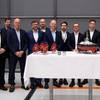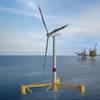The proliferation of sleek, unique and fast ferries on U.S. waterways is slowly becoming the reality that has been much discussed for decades. While the country does not have an inate "ferry mentality" that is so prevalent in the European culture, in part due to the vastly different geographic challenges, many parts of the country, particularly the heavily congested Northeast corridor, are starting to accept the advantages of relatively fast and efficient water transport.
According to a survey conducted by the Volpe National Transportation Systems Center in Cambridge, Mass., high-speed ferries account for only 10 percent of the overall national U.S. ferry fleet. With the option of taking cars, buses and trucks on board, more and more coastal and waterway communities will demand fast ferry transportation to keep traffic afloat.
High speed car ferries in the U.S. are starting to emerge, with the Great Lakes, Hawaii and areas around large cities the primary targets for these vessels.
To that end, there are a number of significant projects to update.
At press time Bay State Cruise Company took delivery of a 149-passenger high-speed ferry from Gladding-Hearn Shipbuilding, Duclos Corporation, for service between Boston and Provincetown, Mass. The new, all-aluminum ferry, designed by Incat Designs, is 98 ft. (29.75 m) long, 29.5 ft. (9.1 m) at the beam, and draws 6 ft. (1.8 m). It is powered by a pair of Cummins KTA38M2 diesel engines, each delivering 1,350 Bhp at 1,950 rpm. The engines turn twin Brutons 5-blade nickel-aluminum-bronze propellers via ZF2550 reverse-reduction gearboxes. The ferry's top speed is 30 knots.
Gladding-Hearn is of course no stranger to the ferry business, having built an enviable reputation building for many of the top operators around the country. Recently New York Water Taxi, whose bright yellow water taxis shuttle passengers between locations on the New York Harbor, ordered two new vessels to add to its six-boat fleet.
Next spring, it will take delivery of two 72-ft. catamarans, under construction at Gladding-Hearn Shipbuilding, Duclos Corporation. The new vessels are classic Incat Designs-designed ferries -- offering simplicity and efficiency, reliability, low sound level, and low wake. The water taxis are designed to reach the same 26-knot speed and with the same crew size as New York Water Taxi's current vessels, but will have twice the interior passenger capacity.
The all-aluminum water taxis measure 72 ft. (22 m) long and 27.3 ft. (2.3 m) abeam, and draw 4 ft. (1.3 m), and each will carry 99 passengers. Each vessel will be powered by two U.S. EPA Tier 2-compliant Cummins QSK 19-M diesel engines, each rated at 800 Bhp at 2100 rpm. The engines will drive 5-bladed Ni-BR-Al (nickel-bronze-aluminum) Bruntons propellers via Twin Disc MGX 5145SC "Quick Shift" gearboxes and EC-300 control systems to improve the vessel's maneuverability and safety when bow landing.
While there have been many significant new ferry deliveries this year: Fairweather built by Derecktor for the Alaskan Marine Highway System; Lake Express built by Austal USA for service on Lake Michicgan; and the aforementioned entries, arguably the most significant U.S. ferry newbuild of the year is the Spirit of Ontario, delivered to Canadian American Transportation System for the commuter route between Rochester, NY, and Toronto, ON.
Built by Austal Ships, the RoPax ferry is truly in a different league. Based on the Auto Express 86 design, a 284-ft. (86.6 m), 774-passenger, 238-vehicle vessel capable of carrying its full load at 45.6 knots.
MTU powerplants help make this vessel special, as four of its state-of-the-art MTU 20V 8000 M70s, generating a cumulative 44,000 hp (32,800 kW) at a rated speed of 1150 rpm, is a core component of its success. Power without performance is useless in the commercial market, so it is worthy to note that fuel consumption is below 195 g/kWh across a very broad power range and less than 190g/kWh at the most economical point, while keeping NOx emissions below the limits required by IMO.
In 2004, two American flagged fast ferries and two carrying foreign flags are working in the USA. The Alaskan Marine Highway System has put the Fairweather in service between the Alaskan ports of Juneau and Sitka. Built by Derecktor Shipyards, Bridgeport, Con., the 232-ft. by 60-ft. auto/passenger ferry can carry 32 vehicles and 250 passengers at 32 knots. Derecktor is building a second vessel for use in Prince William, Sound.
The Austal USA-built the Lake Express is a 192-ft. by 57 ft. auto/passenger ferry capable of holding 253 passengers and 34 vehicles. This vessel will inaugurate cross Lake Michigan service from Milwaukee, Wisc. to Muskegon, Mich.
As more and more fast ferries log significant operating hours on U.S. waters, common thought maintains that ferry systems evaluating the new units will be able be able to judge for themselves the applicability of this ferry concept for their operations, and these evaluations will lead to more construction of these vessels.
Sponsored Content
Innovative Hull Maintenance: Profitable & Green

Subscribe for
Maritime Reporter E-News
Maritime Reporter E-News is the maritime industry's largest circulation and most authoritative ENews Service, delivered to your Email five times per week













